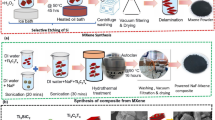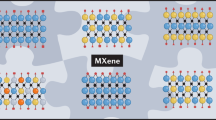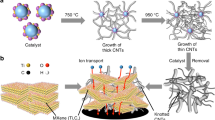Abstract
The use of fast surface redox storage (pseudocapacitive) mechanisms can enable devices that store much more energy than electrical double-layer capacitors (EDLCs) and, unlike batteries, can do so quite rapidly. Yet, few pseudocapacitive transition metal oxides can provide a high power capability due to their low intrinsic electronic and ionic conductivity. Here we demonstrate that two-dimensional transition metal carbides (MXenes) can operate at rates exceeding those of conventional EDLCs, but still provide higher volumetric and areal capacitance than carbon, electrically conducting polymers or transition metal oxides. We applied two distinct designs for MXene electrode architectures with improved ion accessibility to redox-active sites. A macroporous Ti3C2Tx MXene film delivered up to 210 F g−1 at scan rates of 10 V s−1, surpassing the best carbon supercapacitors known. In contrast, we show that MXene hydrogels are able to deliver volumetric capacitance of ∼1,500 F cm−3 reaching the previously unmatched volumetric performance of RuO2.
This is a preview of subscription content, access via your institution
Access options
Access Nature and 54 other Nature Portfolio journals
Get Nature+, our best-value online-access subscription
$29.99 / 30 days
cancel any time
Subscribe to this journal
Receive 12 digital issues and online access to articles
$119.00 per year
only $9.92 per issue
Buy this article
- Purchase on Springer Link
- Instant access to full article PDF
Prices may be subject to local taxes which are calculated during checkout



Similar content being viewed by others
References
Lukatskaya, M. R., Dunn, B. & Gogotsi, Y. Multidimensional materials and device architectures for future hybrid energy storage. Nat. Commun. 7, 12647 (2016).
Conway, B. Electrochemical Supercapacitors: Scientific Fundamentals and Technological Applications (Kluwer Academic/Plenum, 1999).
Simon, P. & Gogotsi, Y. Materials for electrochemical capacitors. Nat. Mater. 7, 845–854 (2008).
Sugimoto, W., Iwata, H., Yokoshima, K., Murakami, Y. & Takasu, Y. Proton and electron conductivity in hydrous ruthenium oxides evaluated by electrochemical impedance spectroscopy: the origin of large capacitance. J. Phys. Chem. B 109, 7330–7338 (2005).
Zheng, J. P., Cygan, P. J. & Jow, T. R. Hydrous ruthenium oxide as an electrode material for electrochemical capacitors. J. Electrochem. Soc. 142, 2699–2703 (1995).
Sassoye, C. et al. Block-copolymer-templated synthesis of electroactive RuO2-based mesoporous thin films. Adv. Funct. Mater. 19, 1922–1929 (2009).
Hu, C.-C., Chang, K.-H., Lin, M.-C. & Wu, Y.-T. Design and tailoring of the nanotubular arrayed architecture of hydrous RuO2 for next generation supercapacitors. Nano Lett. 6, 2690–2695 (2006).
Toupin, M., Brousse, T. & Bélanger, D. Charge storage mechanism of MnO2 electrode used in aqueous electrochemical capacitor. Chem. Mater. 16, 3184–3190 (2004).
Brezesinski, T., Wang, J., Tolbert, S. H. & Dunn, B. Ordered mesoporous [alpha]-MoO3 with iso-oriented nanocrystalline walls for thin-film pseudocapacitors. Nat. Mater. 9, 146–151 (2010).
Come, J. et al. Electrochemical kinetics of nanostructured Nb2O5 electrodes. J. Electrochem. Soc. 161, A718–A725 (2014).
Augustyn, V. et al. High-rate electrochemical energy storage through Li+ intercalation pseudocapacitance. Nat. Mater. 12, 518–522 (2013).
Choi, D., Blomgren, G. E. & Kumta, P. N. Fast and reversible surface redox reaction in nanocrystalline vanadium nitride supercapacitors. Adv. Mater. 18, 1178–1182 (2006).
Naguib, M., Mochalin, V. N., Barsoum, M. W. & Gogotsi, Y. MXenes: a new family of two-dimensional materials. Adv. Mater. 26, 992–1004 (2014).
Ghidiu, M., Lukatskaya, M. R., Zhao, M.-Q., Gogotsi, Y. & Barsoum, M. W. Conductive two-dimensional titanium carbide ‘clay’ with high volumetric capacitance. Nature 516, 78–81 (2014).
Hope, M. A. et al. NMR reveals the surface functionalisation of Ti3C2 MXene. Phys. Chem. Chem. Phys. 18, 5099–5102 (2016).
Halim, J. et al. Synthesis and characterization of 2D molybdenum carbide (MXene). Adv. Funct. Mater. 26, 3118–3127 (2016).
Lukatskaya, M. R. et al. Probing the mechanism of high capacitance in 2D titanium carbide using in situ X-ray absorption spectroscopy. Adv. Energy Mater. 5, 1500589 (2015).
Hu, M. et al. High-capacitance mechanism for Ti3C2Tx MXene by in situ electrochemical raman spectroscopy investigation. ACS Nano 10, 11344–11350 (2016).
Lukatskaya, M. R. et al. Cation intercalation and high volumetric capacitance of two-dimensional titanium carbide. Science 341, 1502–1505 (2013).
Benck, J. D., Pinaud, B. A., Gorlin, Y. & Jaramillo, T. F. Substrate selection for fundamental studies of electrocatalysts and photoelectrodes: inert potential windows in acidic, neutral, and basic electrolyte. PLoS ONE 9, e107942 (2014).
Darling, H. E. Conductivity of sulfuric acid solutions. J. Chem. Eng. Data 9, 421–426 (1964).
Gogotsi, Y. & Simon, P. True performance metrics in electrochemical energy storage. Science 334, 917–918 (2011).
Lin, Z. et al. Capacitance of Ti3C2Tx MXene in ionic liquid electrolyte. J. Power Sources 326, 575–579 (2016).
Yang, X., Cheng, C., Wang, Y., Qiu, L. & Li, D. Liquid-mediated dense integration of graphene materials for compact capacitive energy storage. Science 341, 534–537 (2013).
Mashtalir, O. et al. The effect of hydrazine intercalation on structure and capacitance of 2D titanium carbide (MXene). Nanoscale 8, 9128–9133 (2016).
Li, Y. et al. Synthesis of hierarchically porous sandwich-like carbon materials for high-performance supercapacitors. Chem. Eur. J. 22, 16863–16871 (2016).
Zhu, C. et al. Supercapacitors based on three-dimensional hierarchical graphene aerogels with periodic macropores. Nano Lett. 16, 3448–3456 (2016).
Yoo, J. J. et al. Ultrathin planar graphene supercapacitors. Nano Lett. 11, 1423–1427 (2011).
Chen, C.-M. et al. Macroporous ‘bubble’ graphene film via template-directed ordered-assembly for high rate supercapacitors. Chem. Commun. 48, 7149–7151 (2012).
Lang, X.-Y. et al. Ultrahigh-power pseudocapacitors based on ordered porous heterostructures of electron-correlated oxides. Adv. Sci. 3, 1500319 (2016).
El-Kady, M. F. et al. Engineering three-dimensional hybrid supercapacitors and microsupercapacitors for high-performance integrated energy storage. Proc. Natl Acad. Sci. USA 112, 4233–4238 (2015).
Lindström, H. et al. Li+ ion insertion in TiO2 (Anatase). 2. Voltammetry on nanoporous films. J. Phys. Chem. B 101, 7717–7722 (1997).
Barsoum, M. W. The MN+1AXN phases: a new class of solids: thermodynamically stable nanolaminates. Prog. Solid State Chem. 28, 201–281 (2000).
Pech, D. et al. Ultrahigh-power micrometre-sized supercapacitors based on onion-like carbon. Nat. Nanotech. 5, 651–654 (2010).
Acerce, M., Voiry, D. & Chhowalla, M. Metallic 1T phase MoS2 nanosheets as supercapacitor electrode materials. Nat. Nanotech. 10, 313–318 (2015).
Zhu, M. et al. Highly flexible, freestanding supercapacitor electrode with enhanced performance obtained by hybridizing polypyrrole chains with MXene. Adv. Energy Mater. 6, 1600969 (2016).
Zhao, X. et al. Incorporation of manganese dioxide within ultraporous activated graphene for high-performance electrochemical capacitors. ACS Nano 6, 5404–5412 (2012).
Shen, S., Sudol, E. D. & El-Aasser, M. S. Control of particle size in dispersion polymerization of methyl methacrylate. J. Polym. Sci. A 31, 1393–1402 (1993).
Ling, Z. et al. Flexible and conductive MXene films and nanocomposites with high capacitance. Proc. Natl Acad. Sci. USA 111, 16676–16681 (2014).
Acknowledgements
We thank C.(E.) Ren for help with material synthesis. XRD, SEM and TEM investigations were performed at the Core Research Facilities (CRF) at Drexel University. Y.G., M.R.L. and M.-Q.Z. were supported by the Fluid Interface Reactions, Structures and Transport (FIRST) Center, an Energy Frontier Research Center funded by the US Department of Energy, Office of Science, and Office of Basic Energy Sciences. S.K. was supported by the US National Science Foundation under grant number DMR-1310245. Z.-F. Lin was supported by China Scholarship Council (No. 201304490006). P.S. and P.-L.T. thank the ANR (LABEX STAEX) and RS2E for financial support. M.L. and N.S. acknowledge funding from the Binational Science Foundation (BSF) USA-Israel via Research Grant Agreement 2014083/2016.
Author information
Authors and Affiliations
Contributions
M.R.L. and Y.G. planned the study. S.K., M.R.L., Z.L. and N.S. conducted electrochemical testing. Z.L. and S.K. performed XRD and SEM analysis. M.-Q.Z., Z.L. and J.H. synthesized MXenes and fabricated electrodes. M.-Q.Z. performed TEM analysis. Y.G., P.S., M.R.L., M.D.L., P.-L.T. and M.W.B. supervised the research and discussed the results.
Corresponding authors
Ethics declarations
Competing interests
The authors declare no competing financial interests.
Supplementary information
Supplementary Information
Supplementary Figures 1–9. (PDF 2542 kb)
Rights and permissions
About this article
Cite this article
Lukatskaya, M., Kota, S., Lin, Z. et al. Ultra-high-rate pseudocapacitive energy storage in two-dimensional transition metal carbides. Nat Energy 2, 17105 (2017). https://doi.org/10.1038/nenergy.2017.105
Received:
Accepted:
Published:
DOI: https://doi.org/10.1038/nenergy.2017.105
This article is cited by
-
Nanofeather ruthenium nitride electrodes for electrochemical capacitors
Nature Materials (2024)
-
Significant enhancement of proton conductivity in solid acid at the monolayer limit
Nature Communications (2024)
-
Mn-based MXene with high lithium-ion storage capacity
Nano Research (2024)
-
Versatile MXene Gels Assisted by Brief and Low-Strength Centrifugation
Nano-Micro Letters (2024)
-
MXene-Based Elastomer Mimetic Stretchable Sensors: Design, Properties, and Applications
Nano-Micro Letters (2024)



